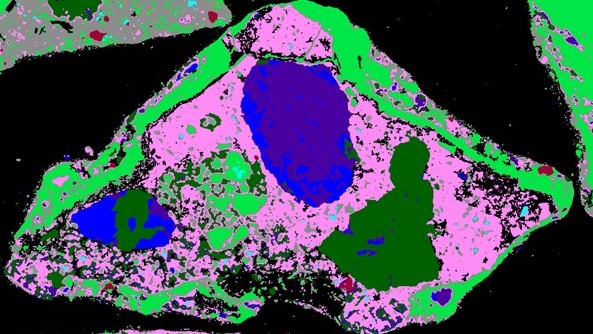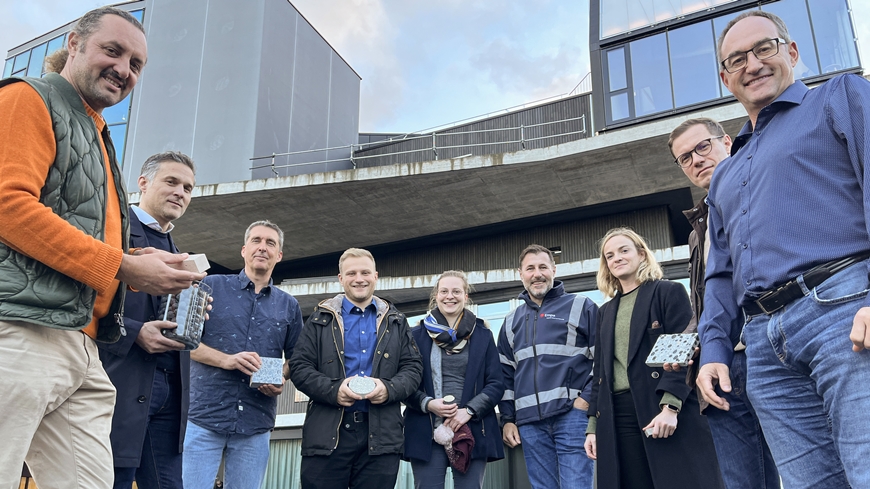Mining the atmosphere
The big clean-up in the atmosphere
If we want to achieve our climate goals, we must not only curb greenhouse gas emissions, but also remove the already emitted CO2 from the atmosphere. Peter Richner, Deputy Director of Empa, explains how to do this while creating a completely new economic system.
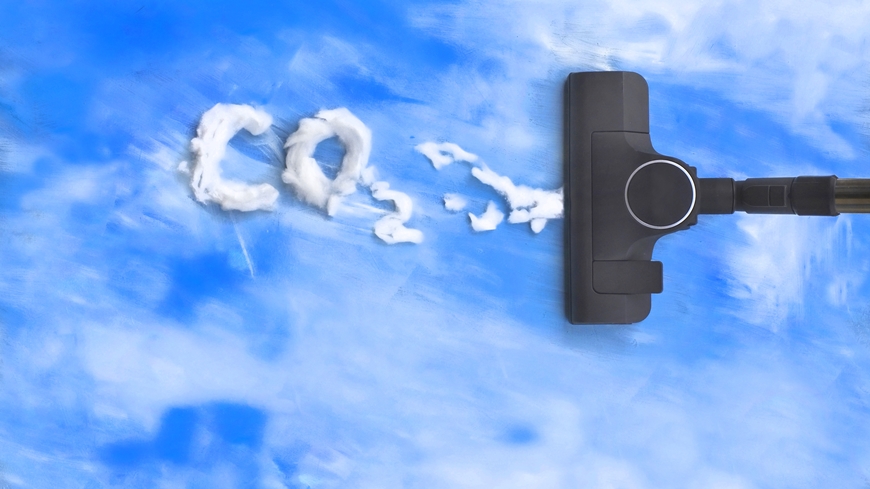
Since the 19th century, cheap energy in the form of coal, oil and natural gas has been the catalyst for a surge in development that has never occurred before in such a short time in human history – and which continues to this day. Productivity has literally exploded, life expectancy in Europe has increased by several decades and the global poverty rate has never been as low as it is today (even though it is still too high in many regions of the world). At the same time, however, rapid growth has also led to overuse of our planet's natural resources. The consequences are dwindling biodiversity and global warming, both of which jeopardize the basis of life in the long term.
Global warming – and thus part of the decline in biodiversity – is due to man-made greenhouse gas emissions, primarily in the form of CO2 and methane. With the Paris Agreement of 2015, which aims to limit global warming, many countries, including Switzerland, have set themselves the goal of reducing their greenhouse gas emissions to net zero by 2050. To achieve this, we must significantly increase the energy efficiency of numerous processes throughout our lives and replace fossil fuels with renewable energies. However, it will hardly be possible to prevent all emissions, for instance in agriculture and other areas. In order to compensate for this – and actually achieve net zero – so-called negative emission technologies (NET) are indispensable, with which the amount of greenhouse gases in the atmosphere can be actively reduced.
One thing is clear: Net zero by 2050 requires huge efforts that go far beyond what Switzerland or other countries have decided and implemented to date. What's more, net zero is only a first step; in the second half of this century, we need to achieve a negative CO2 balance of around 10 to 20 billion tons worldwide – each year! The reason for this is the longevity of CO2 in the atmosphere. While the much more potent greenhouse gas methane is completely degraded within a few decades, CO2 once emitted is only naturally eliminated from the atmosphere over the course of many centuries. Therefore, even at net zero, global warming will not stop or even decrease "overnight". However, if we allow temperatures to remain at a significantly higher level, irreversible changes in the Earth's climate system are likely to occur with consequences that are almost impossible to predict, such as the melting of the Greenland ice sheet, which alone would cause sea levels to rise by almost seven meters.
CO2 as a resource
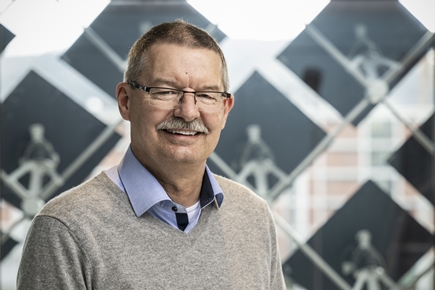
But even if our energy sector succeeds in doing without coal, oil and gas, there is yet another challenge to meet: Crude oil and the like serve as the starting materials for a wide variety of carbon-containing materials, from kerosene to polymers and medicines to bitumen for asphalting our roads. Producing all these materials from biomass is hardly technically possible and would probably far exceed the sustainable supply of biomass available. In other words: We need a new source of carbon.
The answer to this twofold challenge is Mining the Atmosphere. The idea is to remove the excess man-made CO2 from the atmosphere and use it as a resource for carbon-containing materials. We then use these materials in closed cycles for as long as possible before they end up in final sinks. In this way, we ensure that the carbon is fixed for more than 1000 years. The necessary development of materials and processes ultimately promotes the transition from a CO2-emitting to a CO2-binding society.
Empa's research initiative Mining the Atmosphere is – in line with the topic in question – designed for the long term and comprises various "pillars": CO2 extraction, its chemical conversion, applications of the new materials in various areas and systemic considerations such as life cycle analyses. Regardless of which solutions we develop in future, we must never forget one thing – compliance with planetary boundaries.
One key element is the exclusive use of renewable energy in all areas and the question of whether this will be available in sufficient amounts. Our considerations are based on the assumption that this will be the case, not now but in a few decades. The potential is undoubtedly there: The sun sends around 10'000 times more energy to the earth than we need today. In addition, around 99% of our planet is hotter than 1'000 degrees – to name just two of the most important sustainable energy sources.
The "atmospheric raw material" CO2 can be extracted from three sources: directly from the air using Direct Air Capture (DAC), from the oceans, which absorb around a third of anthropogenic CO2, using electrolytic processes, and from biomass. CO2 from the air and the oceans can then be stored directly in suitable geological formations (Carbon Capture and Storage, CCS). With Mining the Atmosphere, however, we are pursuing an alternative path, in which CO2 is converted into short- or longer-chain hydrocarbons using hydrogen and can thus replace existing – mainly fossil – raw materials.
At the same time, existing logistics chains can continue to be used, as chemically, we are dealing with the very same compounds. Key elements for the successful implementation of this idea are catalytic processes for the various chemical conversion reactions and, above all, energy management. This is because the entire scheme depicted here requires a lot of energy. Many of the processes will therefore hardly take place in Switzerland, but rather in places where there is an abundance of renewable energy, such as in the Earth's sunbelt.
In the first phase, we are focusing on two use cases for the application of CO2-based materials: mass products with the potential to bind billions of tons of carbon and products with a high added value, which thus make a significant contribution to financing the project. Building materials account for by far the largest share of global material flows. Carbon-based aggregates for concrete and asphalt as well as thermal insulation materials are therefore currently the focus of our research. The carbon can be obtained either through the pyrolysis of biomass or from synthetic methane, which also supplies hydrogen for energy applications.
With Mining the Atmosphere, we want to show a viable way of avoiding climate change with incalculable risks. However, in order to achieve our goal along this path, we first need to quickly and massively reduce our greenhouse gas emissions and significantly accelerate the expansion of renewable energies. With Mining the Atmosphere, we are already setting the stage for the next chapter – the big clean-up of our CO2-polluted atmosphere.
Communications
Phone +41 58 765 4592
redaktion@empa.ch
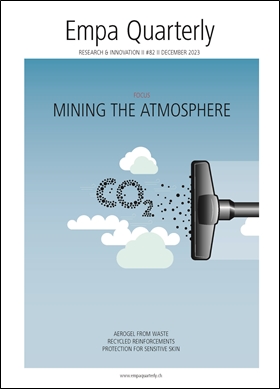
Empa Quarterly#82 Mining the Atmosphere
To limit climate change, we need to compensate not only for future emissions, but also for historical ones. One solution would be the "atmospheric vacuum cleaner": we remove the excess CO2 from the atmosphere. But what do we do with it? Instead of extracting the carbon for polymers, medicines, fibers, fuels and the like from crude oil, we use atmospheric CO2. This is the simple – yet extremely challenging in technical terms – idea behind Empa's new research initiative, Mining the Atmosphere.
Read the EmpaQuarterly online or download the pdf-version.
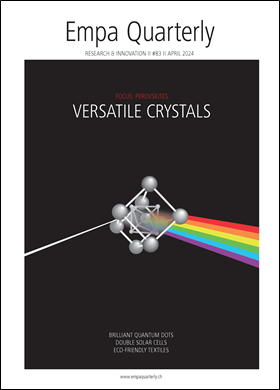
Empa Quarterly#83 Perovskites: Versatile cristals
Over 180 years ago, a curious crystal was discovered in the Ural Mountains. Today, it has given rise to an entire class of materials that is of great interest to researchers: perovskites. What all perovskites have in common is their crystal structure, which gives them unusual properties. By changing the exact composition of the perovskite, scientists can control these properties. Empa researchers are using this promising material to develop solar cells, detectors and quantum dots.
Read the EmpaQuarterly online or download the pdf-version.
-
Share

|
Building on CO2 Chemical processes can bind CO2 in various forms. The construction sector with its huge volumes, is a perfect candidate to making use of them. Empa researchers are working on processes that give reason for optimism. |
|
NEST Podcast |
| The future of construction |
|
Beyond Zero A set of innovations from the Empa labs that are strongly CO2-reduced and even CO2-negative, are going to be installed and analysed inside a new unit at NEST, the innovation building of Empa and Eawag. |







